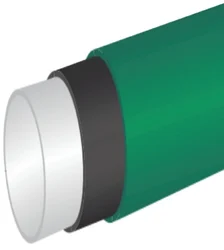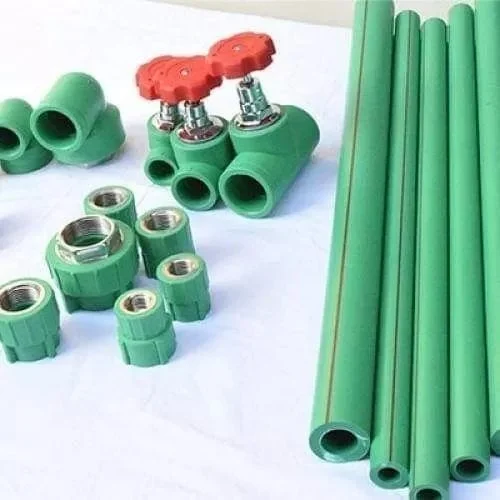Polyethylene (PE) pipes and Polypropylene Random Copolymer PPR pipes ISO 15874 are both commonly used in modern plumbing and piping systems. While both materials offer a variety of benefits, they are suited to different applications based on their unique properties. Below is a comparison of PE and PPR pipes based on several key factors.
1. Material Composition
- PE Pipe: Made from Polyethylene, a versatile thermoplastic, PE pipes are known for their flexibility and chemical resistance. PE comes in several types, including HDPE (High-Density Polyethylene) and LDPE (Low-Density Polyethylene).
- PPR Pipe: PPR pipes are made from Polypropylene Random Copolymer, which is also a thermoplastic but has a different molecular structure compared to PE. PPR is known for its strength and resistance to high temperatures and pressure.
2. Temperature Resistance
- PE Pipe: PE pipes are generally used for cold water applications as they have lower temperature tolerance. They can typically withstand temperatures up to 50°C (122°F) but can soften or deform at higher temperatures.
- PPR Pipe: PPR pipes are better suited for hot water systems, as they can withstand temperatures up to 95°C (203°F) without compromising their structural integrity. This makes them ideal for plumbing, heating, and high-temperature industrial applications.
3. Pressure Resistance
- PE Pipe: PE pipes are highly flexible and can handle moderate pressure. HDPE pipes, in particular, are often used in water distribution and gas supply systems due to their ability to withstand pressure.
- PPR Pipe: PPR pipes have excellent pressure resistance, especially in hot water applications. Their rigidity and strength make them suitable for high-pressure environments, such as plumbing systems in tall buildings.
4. Chemical Resistance
- PE Pipe: PE pipes have excellent chemical resistance and are widely used in industrial applications for transporting chemicals and gases. They resist most acids, bases, and salts, making them suitable for harsh environments.
- PPR Pipe: PPR pipes also have good chemical resistance but are more commonly used for water supply and heating systems. While they handle some chemicals well, PE pipes are generally considered better for aggressive chemical environments.
5. Flexibility
- PE Pipe: PE pipes are highly flexible, making them ideal for applications where the pipe needs to bend or where ground movement is a concern. This flexibility makes PE pipes easier to install in tricky or uneven terrains.
- PPR Pipe: PPR pipes are more rigid compared to PE pipes. While they are durable, they do not offer the same level of flexibility and require more precise installation in straight lines or using appropriate fittings for bends and turns.

6. Ease of Installation
- PE Pipe: PE pipes are relatively easy to install, especially in longer runs due to their flexibility. They can be joined using butt welding, electrofusion, or mechanical fittings, which allow for quick installation.
- PPR Pipe: PPR pipes require heat fusion welding to join, which creates strong and leak-proof joints. However, this process requires specialized tools and skilled labor, making the installation slightly more complex compared to PE.
7. UV Resistance
- PE Pipe: PE pipes, especially black HDPE, have good resistance to UV radiation when used outdoors. This makes them suitable for outdoor applications such as irrigation and water supply systems.
- PPR Pipe: PPR pipes have limited UV resistance, and prolonged exposure to sunlight can cause degradation. If used outdoors, PPR pipes need to be protected with insulation or coatings to prevent UV damage.
8. Cost
- PE Pipe: PE pipes are generally more affordable, especially in large-diameter applications. They are often the go-to choice for large-scale projects like water distribution, gas supply, and irrigation systems.
- PPR Pipe: PPR pipes are typically more expensive than PE pipes, especially due to their higher temperature and pressure resistance. However, the long-term benefits in hot water and high-pressure systems can justify the higher initial cost.
9. Applications
- PE Pipe:
- Water distribution (especially for cold water)
- Gas supply systems
- Irrigation systems
- Industrial chemical transport
- Sewage and drainage systems
- PPR Pipe:
- Hot and cold water supply in residential and commercial buildings
- Heating systems, including underfloor heating
- Industrial piping for high-temperature liquids
- Municipal water supply, particularly for potable water
10. Environmental Impact and Recyclability
- PE Pipe: PE pipes are recyclable and often reused in other plastic products. Their environmental footprint is lower when considering their long life and flexibility in reuse.
- PPR Pipe: PPR pipes are also recyclable and considered eco-friendly. However, their specific uses in hot water systems may result in fewer opportunities for recycling compared to PE in some regions.
Conclusion
Both PE and PPR pipes have their strengths and are suited for different applications. PE pipes offer flexibility, excellent chemical resistance, and are more affordable, making them ideal for cold water, gas supply, and industrial systems. PPR pipes, on the other hand, are more rigid, handle high temperatures and pressures well, and are the preferred choice for hot water supply and heating systems. Choosing between the two depends on the specific needs of the project, including temperature, pressure requirements, and chemical exposure.


















